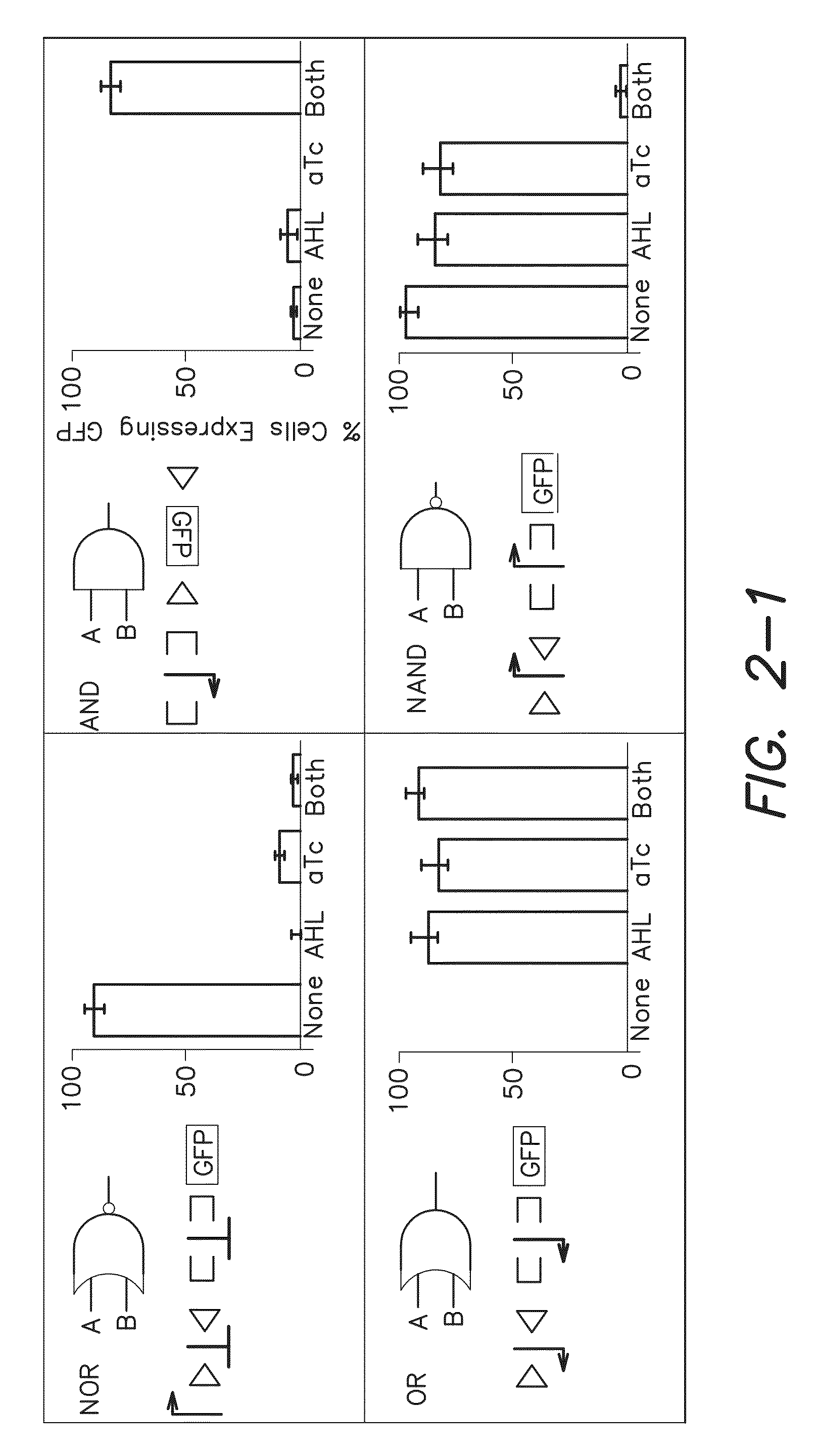Recombinase-based logic and memory systems
a logic and memory system technology, applied in the field of recombinase-based logic and memory systems, can solve the problems of complex logic gates that cannot achieve combinatorial logic, and significant circuit construction and tuning efforts
- Summary
- Abstract
- Description
- Claims
- Application Information
AI Technical Summary
Benefits of technology
Problems solved by technology
Method used
Image
Examples
example 1
Recombinase-Based Logic and Memory Systems
[0183]Serine recombinases, Bxb1 and phiC31, which target non-identical recognition sites known as attB and attP, were used to irreversibly invert or excise DNA based on the orientation of the surrounding pair of recognition sites [11]. To ensure low leakage in the absence of inputs, Bxb1[12] and phiC31[13] were cloned under the control of N-Acyl homoserine lactone (AHL) and anhydrotetracycline (aTc) inducible riboregulators [14], respectively. All cells contained both of these recombinase expression constructs. Herein, Bxb1 expression via AHL is referred to as input A and phiC31 expression via aTc is referred to as input B. The output of the logic and memory systems of the invention were assayed by using green fluorescent protein (gfp) as a reporter gene. The data presented herein demonstrate that Bxb1 and phiC31 operate orthogonally with respect to each other (see the “A” and “B” gates in FIG. 2).
[0184]Recombinase-catalyzed inversion of cas...
example 2
Integrated Logic and Memory in Saccharomyces cerevisiae
[0195]Recombinases are placed under the control of inducible promoters in S. cerevisiae, including, e.g., those that can be controlled by aTc, IPTG, copper and galactose. Recombinases used include phiC31, Bxb1, TP901-1, A118 and U15353. Recombinase activity is tested with reporter constructs containing a promoter (e.g., pCYC1, pADH1, pPGK1) and a downstream inverted gene, such as yeast-enhanced gfp (yEGFP), which is positioned between a pair of inverted recombinase recognition sites (RRSs) (FIG. 32, left). Upon gene inversion due to the recognition of RRSs by cognate recombinases, yEGFP is expressed. Recombinase efficiency is monitored over time with flow cytometry and the measurements confirmed with PCR (e.g., using specific primers that only amplify when the gene is initially inverted as well as primers that only amplify after the gene is flipped) and DNA sequencing. Recombinase inversion efficiencies may be greater than 90% ...
example 3
Computational Algorithms for Automated Design of Biological State Machines
[0198]Recombinase-based circuits for integrated logic and memory can be described by straightforward design rules. For example, when RRSs do not overlap one another and the genetic construct has a straightforward [promoter(s)]-[terminator(s)]-[output] structure (FIG. 1), then gene expression can only occur when: (at least one upstream promoter is upright) AND (no terminators are upright) AND (the output gene is upright). With more complex genetic constructs, such as those with overlapping RRSs, the complexity of the potential permutations increases very rapidly but can still be decomposed into distinct state transitions through simple rules, e.g., recombinase expression leads to inversion of DNA between a pair of inverted RRSs and excision of DNA between a pair of RRSs oriented in the same direction.
[0199]To address the bottleneck of design, computational algorithms that can directly convert a desired state di...
PUM
| Property | Measurement | Unit |
|---|---|---|
| concentrations | aaaaa | aaaaa |
| concentrations | aaaaa | aaaaa |
| concentrations | aaaaa | aaaaa |
Abstract
Description
Claims
Application Information
 Login to View More
Login to View More - R&D
- Intellectual Property
- Life Sciences
- Materials
- Tech Scout
- Unparalleled Data Quality
- Higher Quality Content
- 60% Fewer Hallucinations
Browse by: Latest US Patents, China's latest patents, Technical Efficacy Thesaurus, Application Domain, Technology Topic, Popular Technical Reports.
© 2025 PatSnap. All rights reserved.Legal|Privacy policy|Modern Slavery Act Transparency Statement|Sitemap|About US| Contact US: help@patsnap.com



